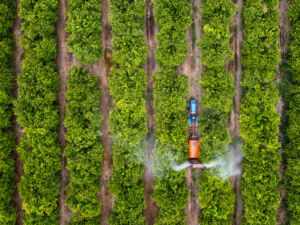Plastic particles are widespread in the environment and, in large quantities, potentially harmful to humans, animals, and ecosystems. Microplastic particles have also been detected in food, with seafood receiving above-average public attention. Many people are therefore very concerned about microplastics in fish and shellfish. However, this concern has so far been based more on media reports than on scientific findings. A recent study, in which ISOE ecotoxicologist Carolin Völker was involved, investigates the intake of microplastic particles via seafood and compares it with other routes of human exposure.
In the study, which was published by an international team of authors in the renowned journal “Environmental Science & Technology Letters” in October, the scientists conclude: The actual contamination of seafood with microplastics is comparable to the contamination in other foods and beverages – and far lower than the amount that humans ingest via indoor air and house dust. Nevertheless, the majority of scientific studies on human exposure to microplastics – over 70 percent – have focused on seafood.
Why this focus? Fish and shellfish were among the first foods studied for microplastics, as early research began in the ocean where contamination was first discovered. In addition, exposure seemed particularly relevant when consuming mussels and shellfish, which are often eaten whole. The authors suggest that this led to an early overemphasis on seafood in media reporting and an overestimation of associated health risks. It has since been shown that other foods and beverages also contain microplastics.
Overemphasis on seafood fuels fears
The authors consider the media focus on microplastic contamination in marine animals to be problematic. They argue that it fuels partly unfounded fears, which could lead to irrational consumer behavior or influence political decisions that are not based on robust data. In order to keep the health benefits of fish and seafood visible, a balanced presentation of facts in the media is needed.
From a scientific perspective, there is currently only minimal evidence that the ingestion of microplastics with food poses any health risk at all; no official consumption warnings exist specifically for microplastics. The available evidence also suggests that the particles pass through the digestive tract and are excreted again. At the same time, uncertainties remain – particularly concerning very small microplastic particles and potential long-term health effects – which require further research.
What we know – and what is still unclear
In their article “Examining misconceptions about plastic-particle exposure from ingestion of seafood and risk to human health,” the authors explain that the amounts of potential pollutants that could enter the body with plastic particles are usually orders of magnitude below toxicologically relevant thresholds. Compared to other exposure sources such as indoor air and house dust, the contribution from food consumption is extremely low.
“It is important to understand that we still know too little about the health consequences of microplastics,” says Carolin Völker, ecotoxicologist at the Institute for Social-Ecological Research (ISOE). “Unanswered questions do not automatically mean a risk, but they do show that we need to take a closer look.” The authors advocate for transparent communication about existing knowledge gaps on the health effects of microplastic particles – avoiding both alarmism and premature reassurance. They emphasize that research on very small particles and possible long-term effects should be further intensified.
Transparency note
The authors of the scientific article “Examining misconceptions about plastic-particle exposure from ingestion of seafood and risk to human health” developed the paper during the symposium “Microplastic and Seafood: Human Health.”, held from September 13 to 14, 2022, at Heriot-Watt University in Edinburgh. The symposium was funded by a consortium of seafood companies from the UK, the US, and Australia. The research itself received no funding from industry or other sources. The article was produced as an independent scientific contribution and underwent peer review.
Contact:



